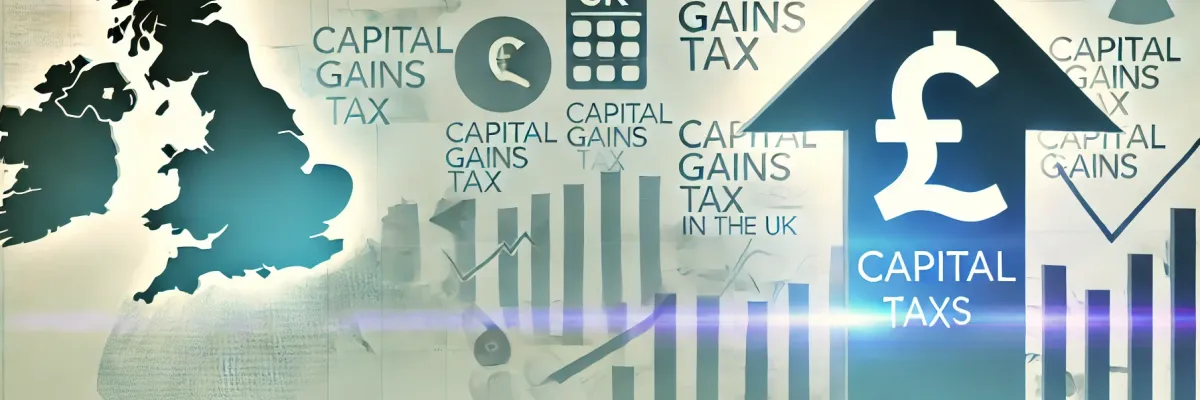Capital Gains Tax
UK Capital Gains Tax (CGT) applies to profits from selling assets such as property or shares. The tax rate varies by income and asset type. Proper planning can reduce your CGT liability. Annual allowances exist, but gains above this threshold are taxable.

A Guide to Capital Gains Tax in the UK
So, you’ve made some money selling something valuable—congratulations! But before you pop the champagne, there’s something you need to consider: Capital Gains Tax (CGT). Don’t worry, it’s not as scary as it sounds, and with a bit of humor, it might even be (dare we say it) fun to understand. Let’s dive into the world of CGT, where the government gets a slice of your financial pie. But hey, it’s all for a good cause, right?
What is Capital Gains Tax?
Capital Gains Tax is the tax you pay on the profit made when you sell (or “dispose of”) an asset that’s increased in value. The key word here is “profit.” You’re not taxed on the total amount you sold the asset for—just the gain you made over what you originally paid. The government isn’t interested in taking all your money (yet), just a portion of the success story.
Example: The Tale of the Lucky Landlord
Imagine you bought a property for £100,000 a few years ago. The market is booming, and you sell it for £150,000. Nice work! But before you get too excited about that £50,000 profit, HMRC (Her Majesty’s Revenue and Customs) wants to know about it. They see that gain and will apply CGT, depending on how much other income you have.
Who Pays Capital Gains Tax?
Not everyone has to pay CGT. For instance, you are likely off the hook if you’re only selling your primary home (the one you live in). But CGT could come into play if you’re selling a second home, shares, or other investments.
CGT Rates
There is more than one rate for CGT, which differs depending on where the gain comes from and who is paying it. The rate is also dependent on your tax rate. These rates are based on the 2024/25 tax year.
Individuals (not including residential property gains and carried interest gains):
- 10% if your total taxable income is below the basic rate threshold.
- 20% if your total taxable income is above the basic rate threshold.
Individuals (for residential property gains and carried interest gains):
- 18% if your total taxable income is below the basic rate threshold.
- 24% if your total taxable income is above the basic rate threshold.
Trustees (not including residential property gains):
- Flat rate of 20%
Trustees (for residential property gains):
- Flat rate of 24%
These rates apply to gains that exceed your annual tax-free allowance (which is £6,000 for the 2024/25 tax year).
But don’t worry just yet—there are some allowances.
Allowances
Every tax year, you get a tax-free allowance for capital gains. For the 2024/25 tax year, it’s £6,000 (down from £12,300 in 2023/24). This means you can make gains up to this amount without paying a penny of CGT. Think of it as a small government-approved jackpot!
Example: Shares to Spare
Let’s say you bought shares for £10,000, and a few years later, you sell them for £18,000. Your profit is £8,000. However, thanks to the annual allowance of £6,000, you only need to pay CGT on £2,000. So, if you’re in the higher tax bracket, you’d pay 28% of £2,000, which equals £560. Not too bad, right? No? Listen, take the win.
Offsetting losses
Not every investment pans out. If you sell an asset for less than you paid, that’s a capital loss. The good news? You can use these losses to offset gains on other assets. If your losses exceed your gains in a tax year, you can even carry them forward to offset future gains. It’s like a little tax-saving cushion for your next adventure.
Example: The Unfortunate Art Investor
Suppose you bought a piece of modern art for £20,000 for your council-owned flat, hoping it would become the next big thing. Sadly, you only sell it for £15,000, making a £5,000 loss. If you also made a £10,000 gain on shares, you could offset that loss, leaving you with a taxable gain of just £5,000.
When Do You Pay CGT?
The deadline for paying CGT is quite generous. You report and pay any tax you owe in your self-assessment tax return by January 31st, following the end of the tax year in which you made the gain. But beware—if you’re selling a property, you have just 60 days to report and pay the tax. That’s right, two months to fork over the cash or face a penalty. Talk about motivation!
CGT on Property: The Juicy Bit
CGT on property can be a bit more complicated. If you’re selling your main home, you usually don’t pay CGT thanks to something called Principal Private Residence Relief (PPRR). However, if you’ve let out part of it, used it for business, or it’s a second home, CGT might apply. And remember those rates? Well, for property, the rates are 18% and 24%, depending on your income tax band.
Example: The Buy-to-Let Blues
Imagine you’re a landlord who bought a rental property for £200,000, and now you’re selling it for £300,000. Your gain is £100,000. After using your £6,000 allowance, you’re left with £94,000 of taxable gain. If you’re in the higher tax bracket, you’d pay 24% of £94,000, which is £22,560. It stings, but you’re still left with a nice profit.
Final Tips
- Plan Ahead: Make use of your annual allowance every year. Spread your sales over multiple years if you can.
- Use ISAs: Gains on investments held in ISAs are tax-free, which makes them a great shelter from CGT.
- Get Advice: Tax rules can be complex, and professional advice is worth its weight in gold—or in this case, saved tax pounds. You could save more than the advice costs.
- Keep Records: HMRC loves paperwork, so make sure you keep detailed records of what you paid, what you sold for, and any costs involved.
Summary
Yes, paying tax is never fun, but with a little knowledge and planning, you can minimize the impact of Capital Gains Tax. Think of it as a necessary part of your journey to financial success—a bit like paying a toll on the road to a great destination. So next time you make a savvy investment, remember: a little CGT is a sign you’re doing something right. And with this guide, you’re well on your way to navigating it with confidence—and maybe even a smile.
Lee Wisener, CeMAP, CeRER, CeFAP
Having worked in the mortgage industry for over 20 years I have always wanted to build a website dedicated to the subject. Also being a geek when it comes to the internet all I needed was time and I could both build the site from scratch and fill it with content. This is it!
Article List
Recent Blog Posts

Grenfell Tower Enquiry Report
04-09-2024
Today, the Grenfell Tower Enquiry Report was released. Am I surprised at the outcome? No, but I am surprised at just how scathing the report has been of everyone, right up to the government level.

New Tax Guides
18-08-2024
I have been asked a few times to create some guides on Tax in the UK. Many people are confused by the rules and, in fact, what taxes can affect the majority of us at some point in our lives. I have put a new section together for these.

Inflation on the rise again
14-08-2024
Inflation has risen following a decent downward run. What does this mean for prices and, more importantly, for mortgage holders regarding interest rates?